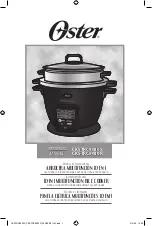
2
3
This is a Listed appliance. The following important safeguards are recommended by most
portable appliance manufacturers.
IMPORTANT SAFEGUARDS
To reduce the risk of personal injury or property damage when using electrical appliances,
basic safety precautions should always be followed, including the following:
1. Read all instructions before using this appliance.
2. Do not touch hot surfaces. Use handles or knobs.
3. To protect against the risk of electrical shock, do not immerse cord, plug, or egg cooker
base in water or other liquids.
4. Close supervision is necessary when any appliance is used near children.
5. Unplug from the outlet when not in use and before cleaning. Allow to cool before putting
on and taking off parts.
6. Do not operate any appliance with a damaged cord or plug, or in the event the appliance
malfunctions or is dropped or damaged in any manner. Return this appliance to the
Presto Factory Service Department for examination, repair, or electrical or mechanical
adjustment.
7. The use of accessory attachments not recommended by the appliance manufacturer may
cause injuries. Use only genuine Presto
®
accessory attachments and replacement parts.
8. Do not use outdoors.
9. Do not let cord hang over edge of table or counter or touch hot surfaces.
10. Do not place on or near a hot gas or electric burner or in a heated oven.
11. Extreme caution must be used when moving an appliance containing hot oil or other hot
liquids.
12. Do not use this appliance for other than intended use.
SAVE THESE INSTRUCTIONS
THIS APPLIANCE IS FOR HOUSEHOLD USE ONLY.
Important Cord Information
This appliance has a polarized plug (one blade is wider than the other). To reduce the risk of
electric shock, this plug is intended to fit into a polarized outlet only one way. If the plug does
not fit fully into the outlet, reverse the plug. If it still does not fit, contact a qualified electrician.
Do not attempt to modify the plug in any way.
A short power supply cord is provided to reduce the risk of becoming entangled in or tripping
over a longer cord. An extension cord may be used if care is properly exercised in its use.
If an extension cord is used, the marked electrical rating of the extension cord should be at
least as great as the electrical rating of the appliance. The extension cord should be arranged
so that it will not drape over the countertop or tabletop where it can be pulled on by children
or tripped over unintentionally.
Connect the power supply cord to a 120VAC electrical outlet only.
Getting Acquainted
Before first use, become familiar with the egg cooker parts (Fig. A) and read the instructions
carefully.
Turn the egg cooker base over and uncoil the cord. Wash the egg cooker parts as instructed
in step 2 on page 5.
Egg Cooker Tips
• Always wash hands, surfaces, and
utensils that have come in contact
with raw eggs.
• Before and after cooking, store eggs
on the lower shelf in your refrigerator
at a temperature at or below 40°F.
• Check eggs for cracks before cooking.
If eggs have superficial cracks, they
are best used for poaching or in
baking rather than hard-, medium-,
or soft-cooking. Cracks in eggs may
allow some of the contents to leak out
during cooking.
• Piercing eggs before cooking should
be avoided. Bacteria can enter the egg
if the piercer or needle is not sterile.
Additionally, piercing causes superfi-
cial cracks in the shell through which
bacteria can enter after cooking.
• The eggs are cooked by steam, and
it is the amount of water used that
determines the cooking time. It may be necessary to adjust the cooking time to achieve the
degree of doneness you prefer. Use additional water to increase the cooking time and the
doneness of the eggs; use less water to reduce the cooking time.
• If cooking less than 12 eggs, position the eggs in any of the larger openings. There is no
need to arrange the eggs in a particular order.
• Eggs that are older are easier to peel than those that are fresh. As the egg ages, the air cell
between the egg and the shell membrane increases in size and helps separate the egg from
the shell.
• For easier peeling, crack the shell all over by gently tapping the egg on the countertop and
then roll it between your hands to loosen the shell. Peel off the shell starting at the large end.
Hold the egg under running water or dip it in water to make peeling easier.
• If not consumed immediately, cooked eggs should be refrigerated within two hours after
cooking and used within one week.
Cover handle
Cover
Fig. A
Poaching
trays
Cooking
tray
Short end
Handle
Egg cooker base
(with cord storage)
Water
reservoir
Signal light
Larger
openings
Handle
Latch
Measuring cup (with
water measurement lines)
Latch
Short end






















